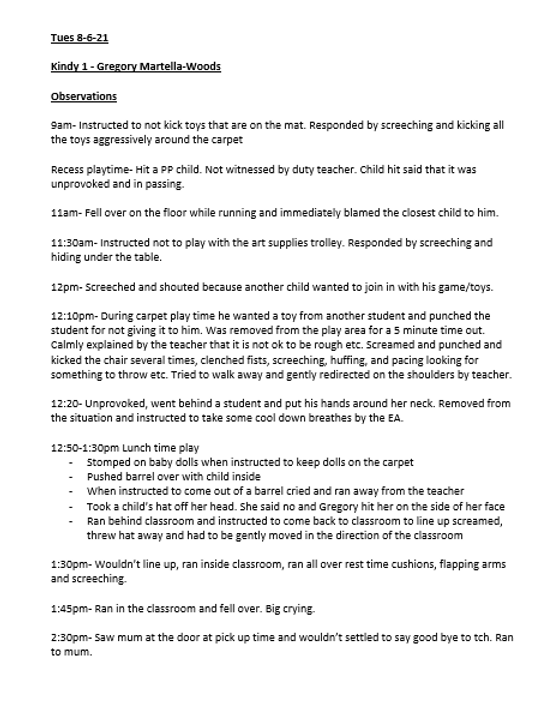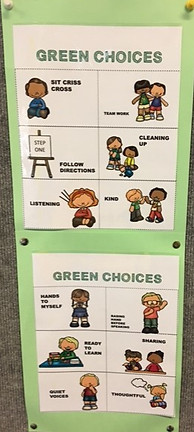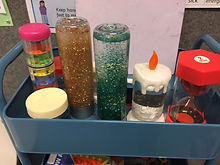4.3 Manage challenging behaviour
AITSL Standard 4.3 Example 1
I manage challenging behaviour by establishing and negotiating clear expectations with students and addressing discipline issues promptly, fairly and respectfully. Below, left, is an extract from the anecdotal notes from Tuesday 8th June outlining Student A's challenging behaviour. When Student A punched another student he was removed from the play area for a 5 minute time out. I calmly explained that it is not ok to be rough and hit other students. When Student A screamed, punched and kicked the chair several times, clenched his fists, screeched, huff and paced looking for something to throw, I spoke to him in a calm manner, acknowledged his feelings and practiced deep breathing with him, E.g. 'I can see that you are feeling angry, let's take some deep breaths together', I then redirected him by the shoulders to play in a calm area of the classroom. The document below, in Figure 1, is the anecdotal notes from Tuesday 8th June regarding Student A's challenging behaviour in which he kicked toys aggressively, hit and punched students, screeched and shouted at both students and adults, ran inside and went behind a student and put his hands around her neck. As a result of this continued challenging behaviour that was unsafe for other students, an email was sent to the Deputy of the school with the anecdotal notes and outlining the need for Student A to be provided with an Educational Assistant in order to keep other students safe. Student A has Global Developmental Delay (GDD) and Autism Spectrum Disorder (ASD). As a result of the email an Educational Assistant was assigned to Student A for two of the three days he attends Kindergarten.

Figure 1 - Anecdotal notes from Tuesday 8th June regarding Student A's challenging behaviour
EYLF Outcomes: 1, 2, 3 & 5
NQS Quality Area: 2, 3, 5 & 7
Domains: Language, Personal, Social, Emotional & Physical
AITSL Standard 4.3 Example 2
Below is an example of how I have managed challenging behaviour and assisted a student in understanding expectations and consequences. Student A has Global Developmental Delay (GDD), Autism Spectrum Disorder (ASD) and often expresses challenging behaviour. With the Educational Assistant I created a space within the classroom for Student A to cool down when he is feeling frustrated, angry or when exhibiting challenging behaviour. In Student A's space is a teepee with a textured beanbag at the bottom and a blanket, see Figure 2 below, it is a safe, cozy place where Student A can calm down. Also within Student A's space is a pin up board with pictures of 'Green Choices' (positive behaviours) and 'Red Choices' (negative behaviours), see Figure 3, these are used as a visual during discussions about both positive and negative behaviours. Figure 4 is a picture of the tray in Student A's space, in the top level are Calm Down Jars, a sand timer and other toys which are helpful in bringing Student A back to the present moment. On the second level of the tray is a spiky ball, an interesting ball that enlarges and contracts, a sensory fidget toy and a superhero book which are all used as calming tools.

Figure 2 - Teepee with a textured beanbag and blanket


Figure 3 - Green and red choices posters



Figure 4 - Calming tools
Figure 5 is an 'I can calm myself down' chart with visuals of calm down techniques, which are used as a visual prompt when managing Student A's challenging behaviour. It outlines strategies that Student A can use when feeling overwhelmed and is a tool that can be used to help calm him down. When Student A is feeling frustrated the 'When I'm Frustrated' chart is used to work through some techniques and acts as a visual prompt, see Figure 6. The two feeling charts in Figure 7 is used to touch base with how Student A is feeling throughout the day to help Student A explore and understand his emotions.

Figure 5 - I can calm myself down chart

Figure 6 - When I'm frustrated visual calming techniques

Figure 7 - Feelings chart to explore and understand emotions
EYLF Outcomes: 1, 2, 3 & 5
NQS Quality Area: 1, 2, 3 & 5
Domains: Language, Personal, Social, Emotional & Physical
AITSL Standard 4.3 Example 3
Below is an example of how I use a behaviour chart within my classroom to manage challenging behaviour and how I communicate challenging behaviour with parents. As well as addressing challenging behaviour, I believe it is important to communicate with parents about their child's challenging behaviour, because there are usually underlying issues and reasons behind the challenging behaviour. This way I can support the child and their family through difficult times.
Figure 8 is an example of the behaviour chart I use in my classroom, at the beginning of the week all students begin on 'Ready to Learn', the students progress up the chart for positive behaviour and down the chart for inappropriate or negative behaviour. At the end of each day the all of the students who have progressed down the chart are put back up to 'Ready to Learn', but the students who have moved up the chart are not moved back to 'Ready to learn' until the end of the week, this allows students a chance to reach the top. When students reach the top of the chart they receive a prize from the prize box, then are moved back to 'Ready to Learn'.
I manage challenging behaviour by establishing and negotiating clear expectations with students and addressing discipline issues promptly, fairly and respectfully. Student B is a student in my class who regularly shows signs of challenging behaviour, however one day it was more than usual. After a time out for his challenging behaviour, I gently spoke to Remy about how he was feeling and ask him if there was any reason why he might have been making some bad choices, however said he didn't know. As a result of his difficult day, I communicated with Student B's mum about his challenging behaviour. When communicating with Student B' mum about his challenging behaviour, she communicated with me that the family was moving house and Student B didn't want to. This information provided me with a reason for Student B's challenging behaviour. Each day for the next week I spoke to Student B about moving house, we spoke about how moving house can be a little scary and sad because we often love our home, it's our special place. We spoke about how a new house can be exciting and something to look forward to even if we have to leave our old home. We talked about packing everything so Student B will have all his special things. I saw a big improvement in Student B's behaviour and things settled down in terms of his challenging behaviour at school.
EYLF Outcomes: 1, 2, 3 & 5
NQS Quality Area: 2, 3, 5 & 6
Domains: Language, Personal, Social, Emotional & Physical

Figure 8 - Behaviour chart